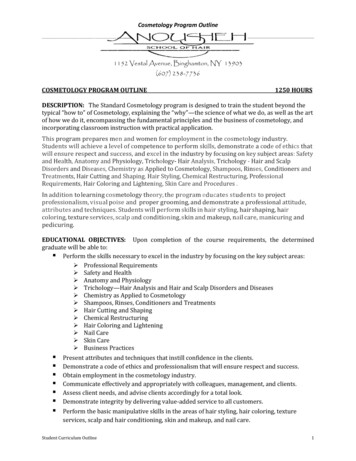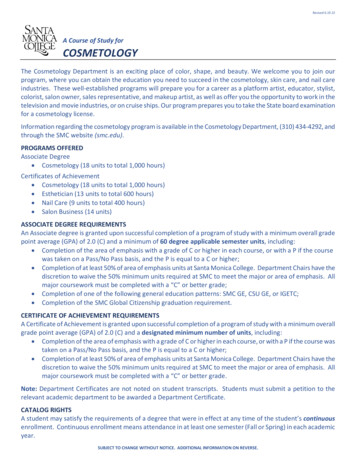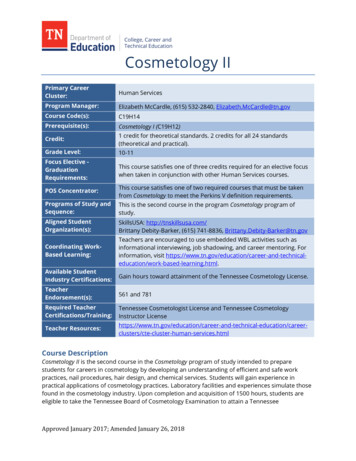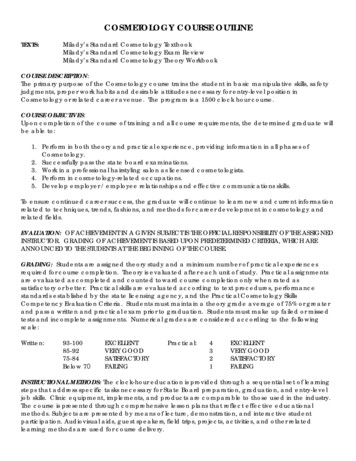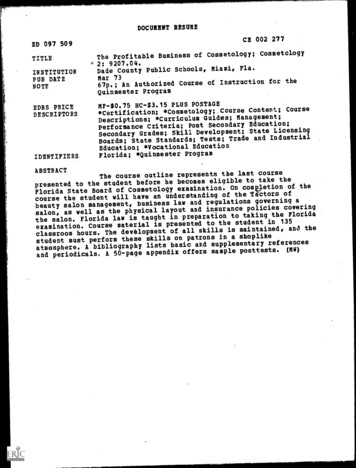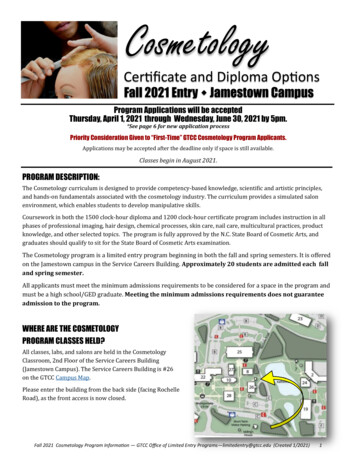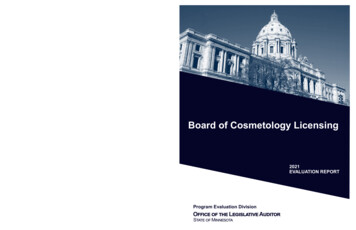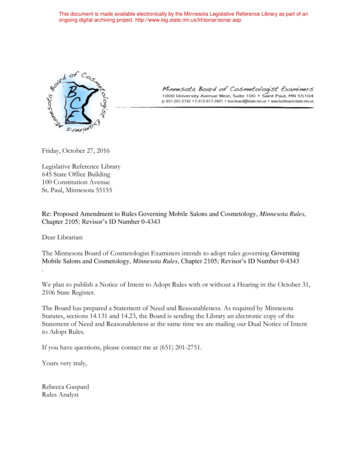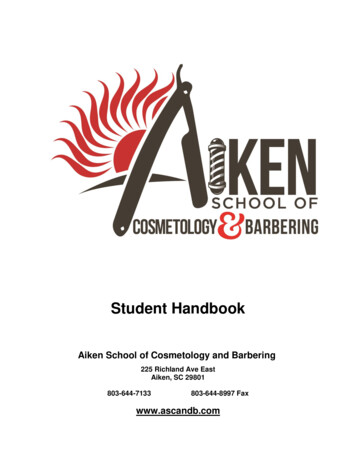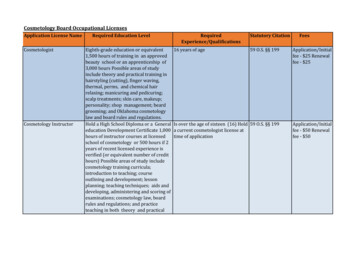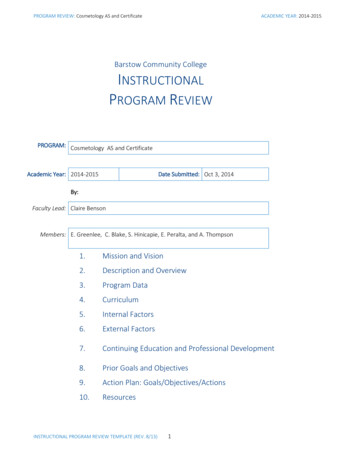
Transcription
PROGRAM REVIEW: Cosmetology AS and CertificateACADEMIC YEAR: 2014-2015Barstow Community CollegeINSTRUCTIONALPROGRAM REVIEWPROGRAM: Cosmetology AS and CertificateAcademic Year: 2014-2015Date Submitted: Oct 3, 2014By:Faculty Lead: Claire BensonMembers: E. Greenlee, C. Blake, S. Hinicapie, E. Peralta, and A. Thompson1.Mission and Vision2.Description and Overview3.Program Data4.Curriculum5.Internal Factors6.External Factors7.Continuing Education and Professional Development8.Prior Goals and Objectives9.Action Plan: Goals/Objectives/Actions10.ResourcesINSTRUCTIONAL PROGRAM REVIEW TEMPLATE (REV. 8/13)1
PROGRAM REVIEW: Cosmetology AS and CertificateACADEMIC YEAR: 2014-20151. Program Mission and VisionA.Program MissionThe Cosmetology Department in sync with the mission of Barstow Community College provides thehighest quality academic, occupational, cultural, and socially responsible environment for studentsin the community. The mission of the cosmetology department is to safeguard and protect thehealth, and general welfare of the consumer establish by the California Board of Barbering andCosmetology. The cosmetology program strives to develop strategies for success, in order, tobridge the skill gap between school and work; developing confidence, skill proficiencies,professionalism, and the understanding of diversity.The cosmetology program strives to give students the finest training and experience available toprepare him or her to qualify to take the State Board of Cosmetology examination for licensure ascosmetologist. The program will continue to do what is best to improve and maintain the highestquality and standards for our student’s education.B.Program Vision (Where would you like the Program to be three years from now?)Barstow Community College recognized as the jewel of the community; the cosmetologydepartment is viewed as an essential technical resource for the students and its community. Thecosmetology department's learning standards seeks to develop the whole person where theindividual is greater than the sum of his or her independent educational experiences, a personwho will understand the world within and the world without.C.Describe how mission and vision align with and contribute to the College’s Mission and VisionCosmetology Department vision in conjunction with College Mission StatementThe Barstow College Cosmetology Department compiles with the mission of the college byproviding career education; courses that give students knowledge, skills, and certificationnecessary for success in the workplace.2. Fostering an innovative learning environment that respects the diversity of individualbackgrounds, abilities, and cultures.3. Partnering with local agencies, businesses, schools, and military bases to promote positivecommunity development and economic growth.1.DATE: October 3, 2014ANNUAL UPDATE#1:Program MissionThe Cosmetology Department has aligned its mission to be synonymous to theBarstow Community College mission to provide our students with the highest qualityeducational tools to achieve personal goals, occupational aims, and professionalgrowth. A priority mission of the cosmetology department is to safeguard andprotect the health, and general welfare of the consumer establish by the California2
PROGRAM REVIEW: Cosmetology AS and CertificateACADEMIC YEAR: 2014-2015Board of Barbering and Cosmetology. The cosmetology program is synchronize withthe college to develop strategies for success, in order, to bridge the skill gap betweenschool and work; developing confidence, skill proficiencies, professionalism, and theunderstanding of diversity.The cosmetology program strives to give students the finest training and experienceavailable to prepare him or her to qualify to take the State Board of Cosmetologyexamination for licensure as cosmetologist. The program will continue to do what isbest to improve and maintain the highest quality and standards for our student’seducational success.DATE: 10-3-2014ANNUAL UPDATE #2: Program Vision (Where would you like the Program to be three years from now?)Barstow Community College recognized as the jewel of the community; thecosmetology department viewed as an essential technical resource for the studentsand its community. Empowering Students to Achieve Their Personal Best ThroughExcellence in Education is the vision of Barstow Community College, and thecosmetology department's learning standards seeks to develop the whole personwhere the individual is greater than the sum of his or her independent educationalexperiences, a person who will understand the world within and the world without.2. Program Description and OverviewAssume the reader does not know anything about the Program. Describe the Program, including—butnot limited to—the following:A.B.C.D.Organization, including staffing and structureWho do you service (including Demographics)?What kind of services does your program provide?How do you provide them?Overview ProgramThe cosmetology program introduces fundamentals of cosmetology practice. The conceptsintroduced include four core competencies, communication skills, critical-thinking, globalawareness, professional role, standards of practice and performance in cosmetology. There arethree pathways to completion of the program: 1600 clock hours, certificate of achievement andassociate of science degree. In the degree and certificate of achievement pathway, generaleducation requirements are mandates.The cosmetology program goal is to serve the community as an affordable, learning-centeredprogram committed to the development and delivery of innovative, successful learners preparedfor the beauty industry. Employed are two full-times, and six adjunct faculty; cosmetology facultyprovide professional experience in current cosmetology practices, and incorporates technology inthe instruction of Cosmetology. In all seven cosmetology courses ranging from beginning,intermediate, and advanced courses, learners develop theoretical and practical competencies3
PROGRAM REVIEW: Cosmetology AS and CertificateACADEMIC YEAR: 2014-2015that prepare them with employable skills. Learner’s ages range from 18 to 60 coupled withdiverse backgrounds and experiences, these elements will develop communities of learning andcontributions to the field of cosmetology.Course DescriptionThe cosmetology program is design to exceed minimum California Board of Cosmetologystandards. The cosmetology program consists of 1600 hours of instruction of both theoretical andpractical skill development required for licensure by the California State Board of Cosmetology. Acombination of lecture and laboratory instruction in a traditional classroom setting includessalesmanship, skills in serving the public; bacteriology, sterilization, principles of sanitation andsafety requirements in operation of a beauty salon/ and or working in the beauty industry. Theprogram details principles of chemistry; laws and administrative regulations. Proficienciesdeveloped include hairstyling, chemical waving, straightening, haircutting, shaping, hair coloring,hair treatments, facials, manicuring (including acrylic nails), and operation of a beauty salon.Cosmetology learners are prepared to become well-trained professionals demanded by today'sbeauty-industry.10-03-2014DATE:ANNUAL UPDATE #1:No changesDATE: 10-03-2014ANNUAL UPDATE #2: No changes3. Program DataA.PERFORMANCE DATA1. Full-Time vs. Part-Time Faculty RatioFull Time3333333COSM20107COSM 50A (20329)COSM 50A (20330)COSM 50B (20331)COSM 50B (20332)COSM 50C (20333)COSM 50C (20334)COSM 51A (20335)COSM 51A (20336)4Part Total201207201303201305Total for All TermsPart Time22221122
PROGRAM REVIEW: Cosmetology AS and CertificateACADEMIC YEAR: 2014-2015COSM 51B (20339)COSM 51B (20340)COSM 51C (20341)COSM 51C (20342)COSM 52 (20337)COSM 52 (20338)112211111100COSM201303COSM 50A (41151)COSM 50A (41152)COSM 50B (41153)COSM 50B (41154COSM 50C (41155)COSM 50C (41156)COSM 51A (41145)COSM 51A (41146)COSM 51B (41157)COSM 51B (41158)COSM 51C (41147)COSM 51C (41148)COSM 52 (41149)COSM 52 (41150)Full-Time22222222112211Part Time22221122111100COSM201305COSM 50A (80305)COSM 50B (8036)COSM 50C (80307)COSM 51A (80308)COSM 51B (80309)COSM 51C (80310)COSM 52 (80311)Full-Time1112231Part Time22222112) Course CompletionFULL TIME201207201303201305Total for All TermsFTFTFTCOSMCOSMCOSMPART TIME201207201303201305Total for All onal8555391153) Course Success and RetentionFULL TIME2012075ENROLLED ATCENSUS160SUCCESSFULCOMPLETION149SUCCESS93%
PROGRAM REVIEW: Cosmetology AS and Certificate201303201305Total for All TermsPART TIMEENROLLED ATCENSUS201207201303201305Total for All Terms4)129383271419436271ACADEMIC YEAR: SUCCESS93%80%94%251WSCH/FTEF RatioTRADITIONAL5)a) Full-time:Not applicable at this timeb) Part-time:Not applicable at this timeONLINEFill RateTRADITIONALa) Full-time:Traditional reports for Full-Time 1stDay/Max 62.10%; Census/Max 47.48%;EOT/Max 43.28%201207201303201305b) Part-time:Traditional reports for Part-Time1st Day/Max 60.71%; Census/Max 45.15%;EOT/Max 41.41%201207201303201305DATE: 10-03-2014ANNUAL UPDATE #1: As enrollment figures for cosmetology each semester commence to decline from 2011to 2013; enrollment strategies to accelerate registration became paramount. The CTEDean, in consultation with the Vice President of Academics decided the effectivesolutions to under-enrolled cosmetology courses would be not to saturate theschedule with repetitive courses each quarter. Therefore, offering BeginningCosmetology courses once a semester will provide higher enrollment throughout thetwo-year cycle for the cosmetology program. The two-year cosmetology plan processavoids excessive numbers of under-enrolled courses, thus, greater enrollment eachsemester.6
PROGRAM REVIEW: Cosmetology AS and CertificateACADEMIC YEAR: 2014-2015DATE: 10-3-2014ANNUAL UPDATE #2: Due to low enrollment, the phasing out of courses offered each quarter led toreduction in faculty. The three full-time faculty are scheduled, the reduction of adjunctfaculty has been reduce from five to three a semester. This is a cost saving measure toexamine high cost/low enrollment programs. As the enrollment commences toescalate, the consideration for rehiring adjunct will again reopen for conversation.B. Progress on Program Level Outcomes (PLOs) and Student Learning Outcomes1)Summarize the progress your program has made on program and/or course level SLO measures.(Include Outcome Statements in this summary.)Program Learning Outcomes:Progress Summary – The cosmetology faculty have focused on the organization and development ofan effective cosmetology program. The cosmetology department has acknowledged and recordedthe program learning outcomes within the framework of the program review for the certificateand degree levels. We have completed two cycles of the assessment process for Program LevelOutcomes. All cosmetology courses have identified their Student Learning Outcomes along withassessment methods. The desired outcomes for the cosmetology program are licensedcosmetology professionals and establishing a learning environment that encourages advancingeducational goals to pursue certificates and degrees, which is critical to meet the challenges of the21st century workforce.2)Describe any program, course, and/or instructional changes made by your program as a result of theoutcomes assessment process.The Board of Barbering and Cosmetology began administering the National-Interstate Council ofState Boards of Cosmetology, Inc., (NIC) practical examination in October 2011. With these newchanges, new rubrics reflect the new requirements. Instructors use techniques moving studentsin the direction of embracing positive learning outcomes and shared learning goals. All instructorscomply with the same method of assessment instruments; therefore, uniformity exists withoutconfusing the learner. The presence of varying degree of practicum in cosmetology performanceassessments, illustrate factual Cosmetology State Board examinations. The rubrics used in studentassessments have proven to be successful and illustrate a replication of the Cosmetology StateBoard examinations.3)Reflecting on the responses for #1 and #2 above, what will you implement for the next assessmentcycle?Achievement assessment at the end of instruction is for certifying mastery of cosmetologypractical application will continue to be part of the assessment cycle. Assessment outcomes aretools for increasing student retention because the likelihood for students to remain in the courseis greater if the instructor provides reinforce practice in the skills that need to be develop. Whenstudents reflect on learned skills, it promotes the process of transformative learning, and targetslearned skills along with self-confidence.DATE: 10-3-2014ANNUAL UPDATE #1: No changes7
PROGRAM REVIEW: Cosmetology AS and CertificateACADEMIC YEAR: 2014-2015DATE: 10-3-2014ANNUAL UPDATE #2: No changesC. Supporting Assessment Data (See Handbook for additional information)1)Provide a list of any additional measures (not included in 3.A.) that you have chosen to gauge yourprogram’s effectiveness (e.g.: transfers, degrees, certificates, satisfaction, student contacts, studentheadcount, Perkin’s data, etc.).The cosmetology program has seven courses aligned with the Board of Barbering andCosmetology Performance Criteria and the National Cosmetology Practical Examination. Thesecourses are also included in the degree pathways for Certificate of Achievement and Associate ofScience degree. A large population of cosmetology learners completes their required 1600 clockhours mandated for licensing. Recorded by the California Board of Cosmetology examinationresults, seventy percent of Barstow’s graduates of the Cosmetology program have acquiredlicensing since 2007. Cosmetology learners engage in specific assignments design to prepare themfor the workforce; students must complete resumes and cover letters. Career-portfolios supporttheir knowledge in the cosmetology field.Degree attainment is not the only definitive measure of student success. In Career and TechnicalEducation, there are other indicators of student success and institutional effectiveness. Adultlearners enroll in the cosmetology program for certification, so that they may rapidly integrateinto the workforce. Completing the 1600 clock hour certification allows adult learners to becomeeligible for licensing for the State of California and gain speedy employment. Therefore, two-yearinstitutions have a range of goals that allow adult learners to acquire associate degrees, transferto four-year universities, obtain or upgrade job-related skills, complete certificate programs, andchange careers.The Cosmetology Club Facebook provides a means of networking with program graduates;therefore, communicates job placements and openings in the beauty industry for Barstowgraduates. This social network is used as an exchange to keep in contact with former graduateswork placement, career and educational progress.Employed inbeautyindustry,salon owners,or onPending filing1600 HRCOMPLETIONTransfer students toother cosmetologyprograms out-ofstate27 STUDENTS2008 32009 42010 52011 82012 42013 32737 STUDENTS14 STUDENTS17 STUDENTS6 STUDENTS2009 62010 102011 102012 52013 6372009 32010 22011 62012 12013 2142009 22010 32011 22012 22013 81795 STUDENTS31520261219952010-2011 Academic Year2011-2012 Degrees/Certificates Awarded8TOTAL2010 42011 26101
PROGRAM REVIEW: Cosmetology AS and CertificateACADEMIC YEAR: 2014-2015Cert-Cosmetology12012-2013 Students Enrolled with Declared MajorEnrolled with Declared MajorCosmetology2010-2011 Academic Year1502010-2011 Degrees/Certificates Awarded3Cert-Cosmetology2)Summarize the results of these measures.After completion of the master content of cosmetology, the performance of the cosmetologylearners is reflected through state licensing certification. The academic years listed below are thenumber of learners who successfully pass the Board of Barbering and Cosmetology licensing.Jan- Dec 2011103)Jan-Dec 20125Jan-June 20136What did you learn from your evaluation of these measures, and what improvements have youimplemented, or do you plan* to implement, as a result of your analysis of these measures? (*Listany resources required for planned implementation in #10: Resources.)Student practical operations and assessments are a key element in measuring cosmetologycompetencies because it provides the opportunity to observe learners skills and validates whatthe student is learning in their coursework. Assessing skills and knowledge of course content bythe application of formative and summative processes is vital.The overall objective for the cosmetology educator is to incorporate teaching strategies thatpromotes successful student learning outcomes. The general program goal is to format a learningenvironment that encourages student-centered classrooms. When students are introduced alearning activity, it is the expectation facilitator for the student to skillfully master thecompetencies mandated for the profession.Continuity reduces student anxiety; it is important that instructors are synonymous withcoursework expectations and provide concrete foundation for students. Using rubrics andassignments for the courses within the framework of the designated textbook standardizes thedelivery of course content for all faculty teaching the coursework.4)9Include DCP Program Assessment Benchmarks, providing analysis of data on long-term goals andobjectives.
PROGRAM REVIEW: Cosmetology AS and CertificateACADEMIC YEAR: 2014-2015Curriculum with continuity becomes a win-win environment for faculty and students. The goal ofcosmetology assessment process evaluates the competencies mandated by the Board ofBarbering and Cosmetology having distinctive advantages. There is the potential to increasestudent learning and assessment tools that enable teachers to adjust instruction to the needs ofthe learning communitySimulated performance in cosmetology attempts to match performance to real workplacesituations. Skilled activities in cosmetology are design to simulate portions of actual jobperformance. Student projects (career portfolio) are comprehensive types of performanceassessments; the projects involve a combination of communication and critical thinking skills.DATE: 10-3-2014ANNUAL UPDATE #1: No changesDATE: 10-3-2014ANNUAL UPDATE #2: No changesD. Two-Year Scheduling Plan1)What is the program’s Two-Year Scheduling Plan? What changes, if any, have been made since thelast Program Review?We have developed a two year cycle for cosmetology coursesFall (Odd Years)Traditional deliveryCOSM 50ACOSM 50BCOSM 50CCOSM 51ACOSM 51BCOSM 51CSpring (Even Years)Traditional deliveryCOSM 50ACOSM 50BCOSM 50CCOSM 51ACOSM 51BCOSM 51CCOSM 52COSM 52Fall (Even Years)Traditional deliveryCOSM 50ACOSM 50BCOSM 50CCOSM 51ACOSM 51BCOSM 51CCOSM 52Spring (Odd Years)Traditional deliveryCOSM 50ACOSM 50BCOSM 50CCOSM 51ACOSM 51BCOSM 51CCOSM 52All of the Program Level Outcomes / Student Learning Outcomes are linked to the CORE Competencies of thecollege: Communication, Critical Thinking, Personal Development, and Global Awareness.10
PROGRAM REVIEW: Cosmetology AS and Certificate2)ACADEMIC YEAR: 2014-2015How effective has the Two-Year Scheduling Plan been in meeting student needs and educationalgoals?The Two-Year scheduling Plan has been a road map for instructors to collaboratively practice team-teaching,faculty development, and a valuable assessment instruments that encourage learners progress from noviceto mastery of cosmetology skills needed to successfully pass the licensing examination. Research nationallyand internationally found that technical graduates are lacking in employability skills. As employability skills arecrucial in outcome-based education, the main goal of the cosmetology program is to develop anemployability skill assessment tool to help produce competent graduates in employability skills needed by theindustry.3)Reflecting on these results, what are the goals for the next assessment cycle?The Cosmetology program is performance-oriented, based on a theoretical and practical application ofinstruction. Students must complete 1600 clock hours along with all required academic courses andlaboratory operations. Focusing on the cosmetology student’s ability to perform specific job-relatedassignments has been central, but needed attention in advancing educational levels should be considered.Instruction of the course of study is based on realistic salon situations and work problems. Promoting asubstantive goal to achieve higher levels of education surpassing the completion of the 1600 clock hours isvital.DATE: 10-3-2014ANNUAL UPDATE #1: Offering Beginning Cosmetology courses once, a semester will provide higherenrollment throughout the two-year cycle for the cosmetology program. The two-yearcosmetology plan proposes measures to avoid excessive numbers of under-enrolledcourses.Two-year cycle for Cosmetology coursesFallTraditional deliveryCOSM 50ACOSM 50CCOSM 51BCOSM 52FallTraditional deliveryCOSM 50ACOSM 50CCOSM 51BCOSM 52SpringTraditional deliveryCOSM 50BCOSM 51ACOSM 51CSpringTraditional deliveryCOSM 50BCOSM 51ACOSM 51CCOSM 52All of the Program Level Outcomes / Student Learning Outcomes are link to the CORECompetencies of the college: Communication, Critical Thinking, Personal Development, andGlobal Awareness.DATE: 10-3-201411
PROGRAM REVIEW: Cosmetology AS and CertificateACADEMIC YEAR: 2014-2015ANNUAL UPDATE #2: The Cosmetology Department will implement a new Two-Year Plan to improve studentenrollment and staffing effectiveness, a plan that will set the educational course for thecosmetology department and ensure maximum efficiency of the CosmetologyDepartment. The purpose of the new Two-Year Plan is to guide the department’s mostimportant priorities and goals about the allocation of resources and student success. Asthe population of students increase, the allocation of additional adjuncts will becomemore functional.4. CurriculumA. List any new courses or program changes since the last program review. Be sure to include any newlyapproved prerequisites or corequisites.Total number of courses in program (break down by discipline if appropriate and helpfulCourse - Number & TitleCOSM 50A BEGINNING COSMETOLOGYIntroductory course pertaining to theory and practical application of rules and regulations, sanitation,professional image, bacteriology, hairstyling and fundamentals of various salon industry techniques.COSM 50B BEGINNING COSMETOLOGYIntroductory course pertaining to theory and practical application of rules and regulations, sanitation, haircutting,draping, shampooing, thermal styling, and hair augmentation.COSM 50C BEGINNING COSMETOLOGYIntroductory course pertaining to theory and practical application of rules and regulations, sanitation, chemicalwaving, curl-reforming, chemical relaxing, haircoloring, and highlighting.COSM 51A INTERMEDIATE COSMETOLOGYIntroductory course pertaining to theory and practical application of rules and regulations, sanitation, manicuring,pedicuring, nail wraps, tips, and acrylic enhancements.COSM 51B INTERMEDIATE COSMETOLOGYIntroductory course pertaining to theory and practical application of rules and regulations, sanitation, basic facial,makeup, eyelash application, and massage movements.COSM 51C INTERMEDIATE COSMETOLOGYIntroductory course pertaining to theory of salon management, soft skills, ethics, business laws and principles,interviewing, and preparing for the workplace.COSM 52 ADVANCE COSMETOLOGYThis course reviews the Board of Cosmetology Performance Criteria and rules & regulations. This courseencompasses all of the theoretical and practical competencies that are required to successfully pass licensing forthe Board of Cosmetology.1. Prerequisites - 90%2. Co-requisites - 0%3. Advisory- ApplicableB. Explain the current evaluation process. How and when the curriculum was last evaluated?(Appropriateness, archiving, deleting, revising, etc.)In 2011-2012 we archived six courses as they are not needed for the certificate and degree pathways.12
PROGRAM REVIEW: Cosmetology AS and CertificateACADEMIC YEAR: 2014-2015C. List any courses not in full compliance with Curriculum Committee Standards, including those that havenot been updated in the past six years (see Curriculum Manual for additional information, if necessary).Due to the Chancellor's Office new requirement for Methods of Instruction, none of our courses are in fullcompliance. We recently reviewed SLOs objectives, and pre-requisites for the courses.Methods of Instruction will be submitted for all courses to curriculum. We should be in full compliance by Fall2013.D. Curriculum Development: What is the plan for maintaining the currency and viability of your curriculum(including all modes of delivery)?Compliance update:Methods of Instruction will be submitted for all courses to curriculum. We should be in full compliance by Fall2013There are no plans to develop any additional courses as to date.courses for online delivery - Not applicable at this timeDATE: 10-3-2014ANNUAL UPDATE #1 Integration of Methods of Instruction for all of the cosmetology courses is complete.The instruction plan for each cosmetology course includes details of methods ofinstruction in the syllabi.DATE: 10-3-2014ANNUAL UPDATE #2: No changes -courses for online instruction continue to be not applicable.5. Internal Factors (see Handbook for worksheet)A. StrengthsThe cosmetology program relocated in 2007 to the main campus of the college, since that time enrollmentcommences to increase each semester. The program recognizes to retain student enrollment it must addresschanging expectations associated with the quality of the learning experience and the wave of technologicalinnovations. The program continues to engage in the traditional approach of learning, but has integratedtechnology to prepare the cosmetology learners for the 21st century work environment. The cosmetologyfaculty will continue to provide quality instruction and create an environment that promotes student success.B. WeaknessesUnfortunately, students have external and internal factors that distract them from their ultimate goal; which,is to complete their program as rapidly as possible. Coupled with these factors are lack of motivation andprocrastination does severely hurt a student when it comes to completing the program. The lack of motivationis a weakness for students, and deters the completion of their program. The cosmetology faculty will continueto keep these students on track to finish their program, as soon as, possible. Cosmetology faculty teachstudents not only course content, modes of thought, strategies for learning and critically thinking about theircourses, workplace, and life experiences.13
PROGRAM REVIEW: Cosmetology AS and CertificateACADEMIC YEAR: 2014-2015DATE: 10-1-2014ANNUAL UPDATE #1: In 2013, the Cosmetology Program implemented a web page on Facebook as aninstrument to locate and track former graduates that achieved cosmetology licensingand working in the beauty industry. This social media allows faculty to compile data oflicensed graduates and monitor their success.DATE: 10-1-2014ANNUAL UPDATE #2: Cosmetology enrollment rate dropped in 2010 through 2013. This was due tosaturation of course offerings, class sizes were below 15 students. Excessive coursescreated faculty/student ratio to be disproportion, requiring a review of the structure ofthe program. As a result, a new Two-Year Plan developed to reflect a more effectivescheduling of courses.In addition, neighboring community administrators linked with the college presidentto recruit potential students in their communities.6. External Factors (see Handbook for worksheet)A. Opportunities14
PROGRAM REVIEW: Cosmetology AS and CertificateACADEMIC YEAR: 2014-2015From Question 3 (What external factors have a significant impact on the program? Include the following, asapplicable)The Cosmetology Department will continue to work to ensure student success in passing the State Boardexamination by providing a learner-centered environment. The faculty will continue to mentor, instruct, leadand guide students in their new professions. The curriculum for the cosmetology is designed to meet andexceed minimum California State Board of Cosmetology standards.Job Market- The Cosmetology Advisory committee members consist of salon owners, cosmetology instructors,former graduates, beauty consultants, beauty school administrator, and director of vocational programs. Themembers have diverse ranges of professional knowledge, expertise, which assists in forecasting future trendsin the beauty field. The currency of the curriculum prepares students for licensing with the California StateBoard of Barbering and Cosmetology.Total employment is expected to increase by 14 percent from 2010 to 2020; changes in consumer demand,improvements in technology, and many other factors will contribute to the continually changing employmentstructure of the U.S. economy. Service-providing industries are anticipated to generate nearly 18 million newwage and salary jobTotal estimated2012 JobsTotal Projected 2020JobsProjected 5657875,43373,0006,755 344,9003,400900COSMETOLOGISTS-ACCOMMODATIONS SERVICES-PERSONAL CAREState ofCaliforniaInland EmpireLos AngelesCountyOrange CountyNational15
PROGRAM REVIEW: Cosmetology AS and CertificateAnnualWages for2013State ofCaliforniaInland EmpireLos AngelesCountyNationalACADEMIC YEAR: 2014-2015Low (25thpercentile)Median (50thpercentileHigh (75thpercentile) 19,101 22,316 28,655 18,303 17,760 19,568 22,000 23,21
Cosmetology. The cosmetology program strives to develop strategies for success, in order, to bridge the skill gap between school and work; developing confidence, skill proficiencies, professionalism, and the understanding of diversity. The cosmetology program strives to give students the finest training and experience available to
